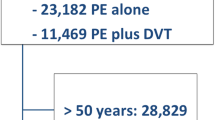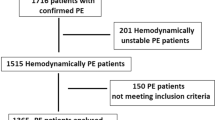Abstract
Pulmonary Embolism (PE) incidence increases with age. Data on mortality and prognosis in elderly patients with suspected PE are lacking. (1) To assess 30- and 90-day mortality in subjects with PE from an elderly population seen in the emergency department (ED); (2) to test the prognostic accuracy of a simplified Pulmonary Embolism Severity Index (sPESI) coupled to a highly sensitive cardiac Troponin T (hs-cTnT) level. A retrospective cohort study was performed, including patients evaluated in the ED of Vimercate Hospital for clinically suspected PE from 2010 to 2012. Study population: n = 470, 63.4 % women, mean age ± SD 73.06 ± 16.0 years, 40 % aged ≥80 and 77.7 % ≥65 years old, confirmed PE: 22.6 % (106 cases). Within 30 and 90 days, mortality among patients with confirmed PE was 14.2 % (8.8–22.0) and 20.8 % (16.5–41.7). In subjects aged ≥80 years, 30-day mortality was 18.9 % among patients with confirmed PE, and 12.6 % among those with PE excluded (p = 0.317). Ninety-day mortality rates were 29.7 and 19.9 %, respectively (p = 0.193). In patients with confirmed PE, Negative Predictive Value of sPESI was 94.1 % (80.3–99.3) for 30 days and 88.2 % (72.3–96.7) for 90-day mortality. Adding the hs-cTnT level to sPESI did not improve its performance. (1) In an elderly population referring to the ED with clinically suspected PE, mortality was high both in subjects with and without confirmed PE; (2) the ability of sPESI and hs-cTnT to predict PE mortality seems to be lower than reported in studies based on data from younger populations. Better risk stratification tools will be necessary to improve clinical management in this setting.

Similar content being viewed by others
References
Kearon C, Akl EA, Comerota AJ, Prandoni P, Bounameaux H, Goldhaber SZ, Nelson ME, Wells PS, Gould MK, Dentali F, Crowther M, Kahn SR (2012) American College of Chest Physicians. Antithrombotic therapy for VTE disease: antithrombotic therapy and prevention of thrombosis, 9th ed.: American College of Chest Physicians Evidence-Based Clinical Practice Guidelines. Chest 141(2 Suppl):e419S–e494S
Becattini C, Agnelli G (2007) Acute pulmonary embolism: risk stratification in the emergency department. Intern Emerg Med 2(2):119–129
Stein PD, Hull RD, Kayali F, Ghali WA, Alshab AK, Olson RE (2004) Venous thromboembolism according to age. The impact of an aging population. Arch Intern Med 164:2260–2265
Ageno W, Agnelli G, Imberti D, Moia M, Palareti G, Pistelli R, Verso M (2013) Prevalence of risk factors for venous thromboembolism in the Italian population: results of a cross-sectional study from the Master Registry. Intern Emerg Med 8(7):575–580. doi:10.1007/s11739-011-0644-1
Piran S, Le Gal G, Wells PS, Gandara E, Righini M, Rodger MA, Carrier M (2013) Outpatient treatment of symptomatic pulmonary embolism: a systematic review and meta-analysis. Thromb Res 132:515–519
Squizzato A, Galli M, Dentali F, Ageno W (2009) Outpatient treatment and early discharge of symptomatic pulmonary embolism: a systematic review. Eur Respir J 33:1148–1155
Aujesky D, Stone RA, Kim S, Crick EJ, Fine MJ (2008) Length of hospital stay and post discharge mortality in patients with pulmonary embolism: a statewide perspective. Arch Intern Med 168:706–712
Park B, Messina L, Dargon P, Huang W, Ciocca R, Anderson FA (2009) Recent trends in clinical outcomes and resource utilization for pulmonary embolism in the United States: findings from the nationwide inpatient sample. Chest 136:983–990
Klok FA, Mos IC, Nijkeuter M, Righini M, Perrier A, Le Gal G, Huisman MV (2008) Simplification of the revised Geneva score for assessing clinical probability of pulmonary embolism. Arch Intern Med 168:2131–2136
Zondag W, Mos IC, Creemers-Schild D, Hoogerbrugge AD, Dekkers OM, Dolsma J, Eijsvogel M, Faber LM, Hofstee HM, Hovens MM, Jonkers GJ, Van Kralingen KW, Kruip MJ, Vlasveld T, de Vreede MJ, Huisman MV (2011) Hestia Study Investigators. Outpatient treatment in patients with acute pulmonary embolism: the Hestia Study. J Thromb Haemost 9:1500–1507
Aujesky D, Obrosky DS, Stone RA, Auble TE, Perrier A, Cornuz J, Roy PM, Fine MJ (2005) Derivation and validation of a prognostic model for pulmonary embolism. Am J Resp Crit Care Med 172:1041–1046
Jimenez D, Aujesky D, Moores L, Gomez V, Lobo JL, Uresandi F, Otero R, Monreal M, Muriel A, Yusen RD (2010) RIETE Investigators. Simplification of the pulmonary embolism severity index for prognostication in patients with acute symptomatic pulmonary embolism. Arch Intern Med 170:1383–1389
Lindner G, Pfortmueller CA, Braun CT, Exadaktylos AK (2014) Non-acute myocardial infarction-related causes of elevated high-sensitive troponin T in the emergency room: a cross-sectional analysis. Intern Emerg Med 9(3):335–339. doi:10.1007/s11739-013-1030-y
Lankeit M, Friesen D, Aschoff J, Dellas C, Hasenfuss G, Katus H, Konstantinides S, Giannitsis E (2010) Highly sensitive troponin T assay in normotensive patients with acute pulmonary embolism. Eur Heart J 31:1836–1844
Becattini C, Vedovati MC, Agnelli G (2007) Prognostic value of troponins in acute pulmonary embolism: a meta-analysis. Circulation 116:427–433
Zwierzina D, Limacher A, Méan M, Righini M, Jaeger K, Beer HJ, Frauchiger B, Osterwalder J, Kucher N, Matter CM, Banyai M, Angelillo-Scherrer A, Lämmle B, Egloff M, Aschwanden M, Mazzolai L, Hugli O, Husmann M, Bounameaux H, Cornuz J, Rodondi N, Aujesky D (2012) Prospective comparison of clinical prognostic scores in elder patients with a pulmonary embolism. J Thromb Haemost 10:2270–2276
Polo Friz H, Pasciuti L, Meloni DF, Crippa M, Villa G, Molteni M, Primitz L, Del Sorbo D, Delgrossi G, Cimminiello C (2014) A higher d-dimer threshold safely rules-out pulmonary embolism in very elderly emergency department patients. Thromb Res. 2014(133):380–383
Giannitsis E, Kurz K, Hallermayer K, Jarausch J, Jaffe AS, Katus HA (2010) Analytical validation of a high-sensitivity cardiac troponin T assay. Clin Chem 56:254–261
Vasco B, Villalba JC, Lopez-Jimenez L, Falga C, Montes J, Trujillo-Santos J, Monreal M (2009) RIETE Investigators. Venous thromboembolism in nonagenarians. Findings from the RIETE registry. Thromb Haemost 101:1112–1118
Aujesky D, Roy PM, Verschuren F, Righini M, Osterwalder J, Egloff M, Renaud B, Verhamme P, Stone RA, Legall C, Sanchez O, Pugh NA, NGako A, Cornuz J, Hugli O, Beer HJ, Perrier A, Fine MJ, Yealy DM (2011) Outpatient versus inpatient treatment for patients with acute pulmonary embolism: an international, open-label, randomised, non-inferiority trial. Lancet 378:41–48
Lankeit M, Jiménez D, Kostrubiec M, Dellas C, Hasenfuss G, Pruszczyk P, Konstantinides S (2011) Predictive value of the high-sensitivity troponin T assay and the simplified Pulmonary Embolism Severity Index in hemodynamically stable patients with acute pulmonary embolism: a prospective validation study. Circulation 124:2716–2724
Conflict of interest
The authors declare that they have no conflict of interest.
Author information
Authors and Affiliations
Corresponding author
Rights and permissions
About this article
Cite this article
Polo Friz, H., Molteni, M., Del Sorbo, D. et al. Mortality at 30 and 90 days in elderly patients with pulmonary embolism: a retrospective cohort study. Intern Emerg Med 10, 431–436 (2015). https://doi.org/10.1007/s11739-014-1179-z
Received:
Accepted:
Published:
Issue Date:
DOI: https://doi.org/10.1007/s11739-014-1179-z




